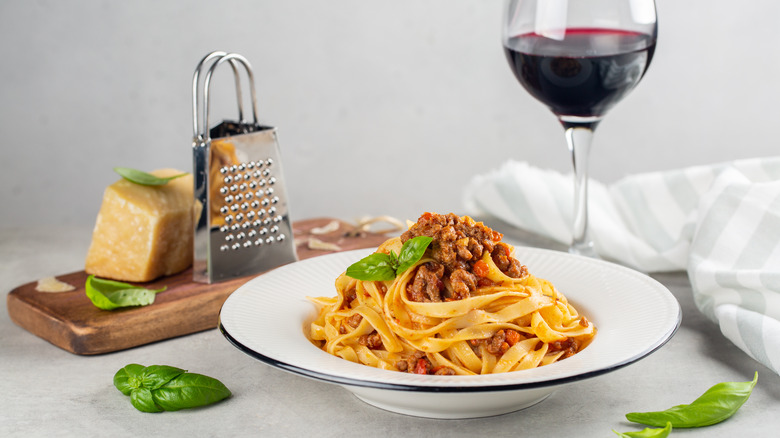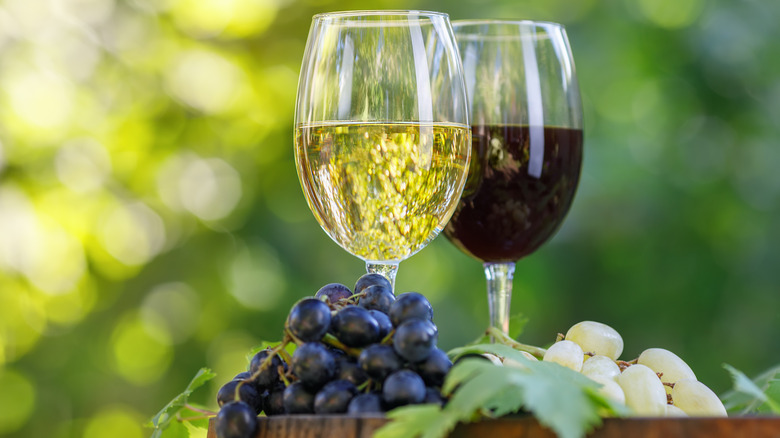Ina Garten's Favorite Wine To Use When Making Bolognese
A classic bolognese is one of those dishes that seems simple on the surface, but actually, there's a lot going on. Many people around the globe have their own take on the dish and variations can veer substantially from the original creation, which hails from the Italian city of Bologna and takes several hours to cook. Ina Garten has added her own spin to create a much quicker version you could knock up on a weeknight, but still incorporates many of the much-loved flavors — including an Italian wine.
The official recipe for ragu alla bolognese as published by Accademia Italiana della Cucina (the Italian Academy of Cooking) does not contain garlic or herbs, and would certainly not be served with spaghetti, but it does contain wine. Ina Garten ditches the spaghetti for bolognese, too, preferring orecchiette pasta to soak up the meaty sauce — though she does add garlic, dried oregano, and red pepper flakes. When it comes to the wine, which adds extra body and depth to the dish, the Barefoot Contessa prefers to use chianti, a dry red from Tuscany.
Chianti has been protected by the official D.O.C.G. mark (meaning Denominazione d'Origine Controllata e Garantita, or Controlled and Guaranteed Denomination of Origin) since 1984. But it's the "great flavor" the Italian wine brings to a bolognese that Garten especially enjoys (via YouTube).
Ina Garten uses a dry chianti to enrich bolognese
A blend made mostly (at least 80%) from Sangiovese grapes, chianti is a dry wine with high acidity. Its aromas and flavors are unmistakably Italian, with notes of balsamic vinegar, tart cherries, herbs such as oregano, and even a hint of espresso. No wonder it goes so well with food.
Ina Garten is such a fan of the unique taste and depth of flavor the red wine gives a meaty ragu that she adds it not just once, but twice to her bolognese dish. A cup of the earthy wine at the start of the cooking process means the alcohol has time to cook down a little with the ground sirloin and other ingredients, which mellows its taste. Another ¼ cup added towards the end really doubles down on the chianti's flavors and, as Garten says, gives the finished dish "a little edge" (via YouTube).
In addition to bolognese, chianti makes a great match for drinking alongside a number of Italian dishes, as well as when cooking recipes such as duck with cherries in chianti. It goes especially well with pasta dishes featuring tomato-based sauces where the wine's acidity nicely balances the fruit's subtle sweetness. For similar reasons, pizza is also a good bet — especially a classic Margherita, one of the most influential international dishes of all time. Or try it with meaty ragus, game, or even with a steak.
Is red or white wine best for bolognese?
While Ina Garten's choice of dry chianti brings out the natural flavors in a tomato and meat ragu, the question of which wines should go in a bolognese remains a little controversial. Even whether you should use a red or white wine is a source — or should that be sauce — of much debate.
The Italian Academy of Cuisine's official recipe from 1982 originally specified half a glass of dry white wine (per The Wayback Machine). But by 2020, it recommended red wine (via The Wayback Machine), and in the most recent 2023 version, this has been adapted to suggest either red or white wine. As for Italian chefs and cookery writers, it's red for both Anna Del Conte and the late Antonio Carluccio – whereas Marcella Hazans preferred a dry white.
So which is best when choosing a cooking wine? It really depends on factors such as the other ingredients in the dish, how fatty the meat is, and whether you prefer a higher acidity bold red or a lighter dry white. It seems there's no official correct answer anymore. So just trust your palate and personal preference. But maybe don't get overly enthusiastic and add a splash of brandy, too; that remains a big no-no in the official recipe. Some traditions still hold.



